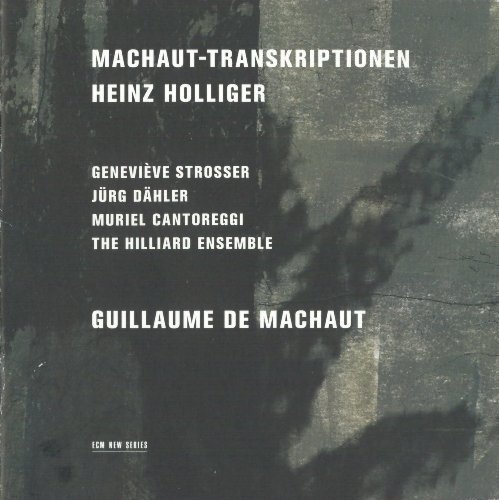Geneviève Strosser, Jürg Dähler, Muriel Cantoreggi & The Hilliard Ensemble - Heinz Holliger: Machaut-Transkriptionen (2015)

Artist: Geneviève Strosser, Jürg Dähler, Muriel Cantoreggi & The Hilliard Ensemble
Title: Heinz Holliger: Machaut-Transkriptionen
Year Of Release: 2015
Label: ECM Records
Genre: Classical
Quality: FLAC (image + .cue, log, artwork)
Total Time: 01:05:29
Total Size: 255 MB
WebSite: Album Preview
Tracklist:Title: Heinz Holliger: Machaut-Transkriptionen
Year Of Release: 2015
Label: ECM Records
Genre: Classical
Quality: FLAC (image + .cue, log, artwork)
Total Time: 01:05:29
Total Size: 255 MB
WebSite: Album Preview
1. Ballade IV Biaute qui toutes autre pere
Machaut-Transkriptionen
2. Ballade IV für drei Violen
3. Ballade XXVI Donnez, Seigneur
Machaut-Transkriptionen
4. Ballade XXVI für drei Violen
5. Double Hoquet (Hoquetus David)
Machaut-Transkriptionen
6. Triple Hoquet (nach Hoquetus David)
7. Lay VII für vier Stimmen
8. In(ter)ventio a 3 und Plor-/ Prol - / Or - atio für drei Violen
9. Complainte (aus: Remede de Fortune) und Epilog für vier Singstimmen und drei Violen
The music on this album does not really include transcriptions as that word is used in English. What you get are three pieces by Machaut himself, performed in straightforward vocal versions by the Hilliard Ensemble, and six compositions by Heinz Holliger (known to average classical listeners as a Swiss virtuoso oboist, but increasingly active as a composer) that are designated as "nach Machaut" ("after Machaut"). All the Holliger pieces are for three violas. The first three of these are based on the Machaut pieces that precede them on the program, while the last three depart to a greater degree from Machaut: one adds parts to a monophonic lai; one is a free fantasy called "In(ter)ventio"; and the grand 15-minute finale brings the voices and instruments together in a reworking of a section of the epic poem La remède de fortune. Holliger's musical language gradually stretches that of Machaut until the link consists of little more than intervals and sonorities, but the final piece is still recognizably Machaut-derived; the use of the syncopation-like device of hocket is retained. Whatever you think of this whole thing, two contentions would be hard to argue with: first, Holliger has devised a neo-medieval language that is very much like nothing anybody else has done before; and second, it would be hard to find an engineering team more suited to the enterprise than that at the ECM label. Many possessors of good sound equipment will want this release purely for the almost frightening detail and clarity in the contrast of the vocal and viola groups, brought together by Holliger for a slam-bang finale. An unusually satisfying experiment involving the music of a composer whose legacy has still hardly been explored creatively. -- James Manheim
![Nābu Pēra - Soundscapes of Nicosia (2025) [Hi-Res] Nābu Pēra - Soundscapes of Nicosia (2025) [Hi-Res]](https://img.israbox.com/img/2025-12/14/lhs20jten1ip5ht0uibyjocfe.jpg)



![Tomasz Stańko - Piece for Diana and Other Ballads (Polish Radio Sessions vol. 1/6) (2025) [Hi-Res] Tomasz Stańko - Piece for Diana and Other Ballads (Polish Radio Sessions vol. 1/6) (2025) [Hi-Res]](https://www.dibpic.com/uploads/posts/2025-12/1765788761_cover.jpg)



![Eshon Burgundy - Safe Place (Bossa Nova Jazz) (2025) [Hi-Res] Eshon Burgundy - Safe Place (Bossa Nova Jazz) (2025) [Hi-Res]](https://www.dibpic.com/uploads/posts/2025-12/1766079194_cover.jpg)